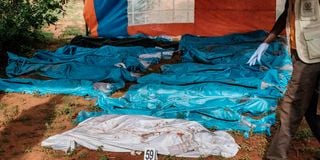Shakahola cult: Victims’ families in agony as results of DNA tests delayed

Delay in the release of DNA results for victims of the Shakahola cult has left families in agony, not knowing whether their relatives are alive or dead.
In May, the government launched a DNA testing exercise for families who believe their relatives are among those missing or found dead in Kilifi’s Shakahola forest. But almost two months later, they are still waiting for the results.
One of them is Rogers Mwibo. He says his mother, sister and niece, ardent followers of controversial preacher Paul Mackenzie of the Good Life International Church, moved to the forest a year ago. He says he immediately had his DNA taken in both Nairobi and Malindi following the government’s announcement.
“I was advised to have my DNA samples taken at the Kenyatta National Hospital because I was in Nairobi at the time. However, I later went back to Malindi for the same process. I hope that my family members will be found alive. I have checked with a number of people who have confirmed that my sister Maureen and her daughter Neema are buried in Shakahola, but we are not allowed to visit the graves,” he said.
Mwibo and 200 other families are still waiting for the DNA results, with no idea when they will be released. They have no idea whether their relatives are among the more than 420 bodies lying in the Malindi Sub-County Hospital mortuary.
“I got a call from the Kenya Red Cross two days ago and I thought there was an update. But it was the usual call asking if I had my DNA taken. They keep telling us they will call with an update, but that has never happened,” says Mwibo.
DNA testing is the scientific comparison of genetic profiles of people or bodies people with those of others to establish if they are related. It involves taking samples of muscle, bone or teeth. The results of the comparison of samples are usually given as percentages.
Coast Regional Commissioner Rhoda Onyancha confirmed that 266 DNA samples had been taken so far.
“We cannot say when we will release the results because we are still exhuming. Until we complete the exhumation process and are satisfied that we have really covered the ground, we will then move on to the other processes,” she told the Nation.
As of Friday, the death toll stood at 425. So far, the government has carried out exhumations in three phases and performed post-mortem examinations on 338 bodies.
While starvation appeared to be the main cause of death for 99 victims, some of the others, including children, were strangled (14), bludgeoned or suffocated, according to Chief Government Pathologist Johansen Oduor, who led the post-mortem examination exercise.
The cause of death for 66 bodies could not be determined, with Dr Oduor describing them as badly decomposed.
One of the victims is said to have died of complications in childbirth, while three others succumbed to illnesses including kidney failure.
Those who died were buried on the sprawling 800-acre farm in the forest, nearly 70 kilometres from Malindi.
Interior Cabinet Secretary Kithure Kindiki noted that it will take long to complete the DNA process when he appeared before the Senate’s ad hoc committee on the proliferation of religious organisations chaired by Tana River Senator Danson Mungatana.
“The release of the remaining bodies of our people to their loved ones is a long process because the DNA profiling and matching process will take some time and there is very little we can do,” he said. He added that the process of recovering bodies in the forest was taking longer because they were following international law on genocide.
“We have built entrances into the Shakahola forest and we are searching metre by metre, centimetre by centimetre and millimetre by millimetre. In some cases, we discovered that Mackenzie had grown some vegetables, such as kunde, on top of the mass graves. He had also built house-like structures to hide the graves,” said Prof Kindiki.





